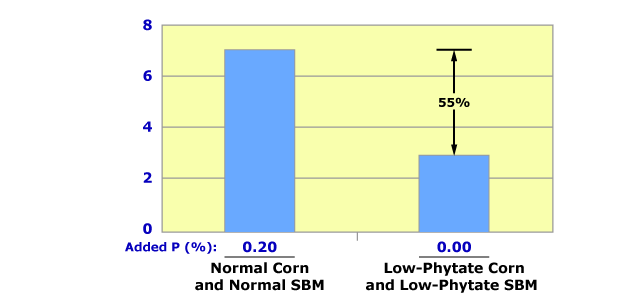Week 10
Swine |
 |
 |
Instructions for listening to audio clips
- Download the QuickTime
Player to listen to the audio files.
- Read the QuickTime
Instructions for installation help.
- Download the RealPlayer to listen to the audio files
- Instructions are on the RealPlayer download page
Ration Formulation to Manage Nutrients
Text
Transcript
Follow along with the audio...
Ration Formulation to Minimize Waste
- Animal production has increasingly grown highly specialized, industrialized
and concentrated geographically
- During the last decade, environmental concerns have become important
issues in animal agriculture.
- Manure disposal and odor control have become particularly important
issues where concentrated confinement systems are utilized.
- The primary goal of producers and nutritionists has traditionally
been to maximize performance by formulating diets via a “safety margin”
approach.
- Nutritionists now must now formulate diets and develop feeding programs
that both optimize production AND minimize nutrients
excreted (e.g. N, P) and odors produced.
Traditional Approaches and Problems
- Land application has been the major means of using manure
- However there is increasing concern over the negative impact such
practices have on the quality of both surface and ground water
- Two approaches have been adopted to meet this challenge:
- Reduce the amount of nutrients being excreted
- Ensure that nutrients that are excreted can be recycled in a sustainable
manner that does not hurt air/groundwater/soil quality
Decreasing Nitrogen Excretion in Swine
- Basic approach: Application of Ideal protein concept (accurately
determine protein requirements and supply dietary requirements with
minimal excess)
- Areas of nutritional research aimed at meeting these goals:
- Develop more accurate requirement values
- Know digestibility of the AA in ingredients being fed
- Feed most digestible ingredients economically possible
- Implement phase feeding (match feed to stage of growth)
- Feed males and females separately
- Decrease the margin of safety in the concentrations of nutrients

Phase Feeding: Growing-Finishing Pigs
- Growing Phase - to 100-125 lbs
- 1480 kcal ME/lb, 18% CP, 0.95% Lys
- Finishing phase - to 240 lb
- 1485 kcal ME/lb, 16% CP, 0.80% Lys
- Split sexes
- Barrows eat and gain more (18/15% CP)
- Gilts more efficient (feed:gain) and leaner (18/17%)
Synthetic Amino Acids Decrease Waste Nitrogen
- Lower dietary protein by 2 % points and supplementing the diet
with crystalline lysine is one of the most effective ways to decrease
N excretion in pigs (Klopfenstein et al, 2002)
- Reduces nutrition excretion by 20-25% (Pierce et al., 1994)
in growing pigs
Decreasing Phosphorus Excretion in Swine
- Most P in cereal grains is in the form of phytate
- Swine and poultry lack sufficient quantities of the intestinal
enzyme phytase to utilyze P efficiently
- Strategies to decrease P excretion:
- Avoid excessive fortification of diets with P (commonly done
in past)
- Use highly available P Sources
- Supplement diet with Microbial Phytase
- Use genetically engineered Low-phytate corn and soybean meal
Effect of Low-Phytate Corn on P excretion

|


